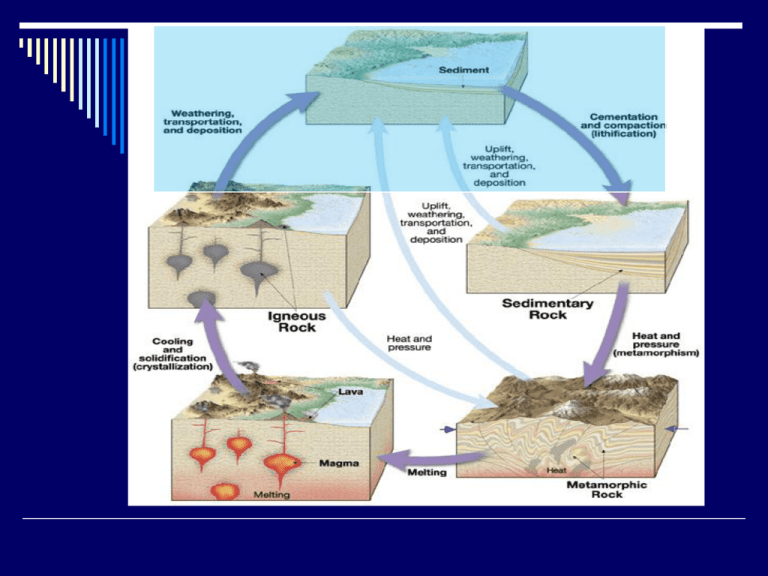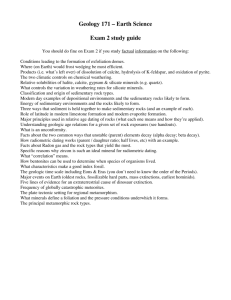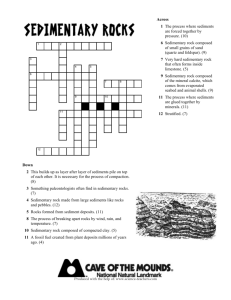Chapter 7
advertisement

WHERE DO SEDIMENTS ORIGINATE? Fig 5.12 WEATHERING OF PRE-EXISTING ROCKS HOW ARE SEDIMENTS MOVED? (ERODED/TRANSPORTED) • water • wind • ice • gravity WHERE DO SEDIMENTS ACCUMULATE? 75% OF SURFACE ROCKS ARE SEDIMENTARY. JUST LIKE IGNEOUS ROCKS: •TEXTURE MEANS SIZE OF GRAINS Fine-grained Coarse- grained Sedimentary Rocks: Form in surface environments (75% of earth’s surface) Classified according to texture (in part) Reflect conditions of environment of formation Accumulate in layers over time (can be “read” like pages in a book) JUST LIKE IGNEOUS ROCKS: •TEXTURE IN SEDIMENTARY ROCKS IS A MEANS TO CLASSIFY ROCKS • BUT ALSO TELLS US ABOUT FORMATION OF ROCK … • TEXTURE RELATES TO ENERGY OF ENVIRONMENT OF DEPOSITION WATER SORTS SEDIMENTS ACCORDNG TO SIZE, SO TEXTURE TELLS US ABOUT ENERGY OF E.O.D. Increasing energy = Increasing particle size Layered nature of sedimentary rocks reflects depositional processes What are SOURCES of sediments for sedimentary rocks? Mechanical Weathering Chemical Weathering KAlSi3O8 + H+ + HCO3- + H2O Potassium feldspar ►► Introduced in solution Al2Si2O5(OH)4 + K+ + HCO3- + SiO2 Clay mineral Carried away in solution Products from mechanical /chemical wxg Dissolved minerals Solids (residuals) From chem. wxg (in solution) secondary minerals Primary minerals from chemical wxg from mechanical wxg (clays, iron oxides) (quartz sand) CHEMICAL DETRITAL Minerals + organics = SOIL (CLASTIC) SED RX SED RX breccia conglomerate Conglomerate & breccia very coarse-grained detrital rocks formed in high-energy environments Sandstone* a coarse-grained detrital rocks formed in a medium to high-energy environment. * composition of grains is commonly quartz Shale* a fine-grained detrital rock formed in a low-energy environment (most common sedimentary rock). * Composition of grains is almost always clay Limestone* a chemical rock formed in a variety of environments, often with the assistance of organisms (most common chemical sedimentary rock). *composition is always calcite (CaCO3), grain size is variable Weathering Chemical Weathering Processes: • Solution of calcite • CO2 + H20 ► H2CO3 • CaCO3 + H2CO3 ► Ca 2+ + 2 (HCO3)solid 29 solution solution solution Formation of Limestone Precipitation of Calcite • CaCO3 + 2 H+ + (CO3)2- solid 30 solution Ca 2+ + 2 (HCO3)- solution solution Rock Salt: a chemical rock formed from evaporation of water (evaporite) Sedimentary processes and life processes are intermingled Fossils are evidence of past life. They are concentrated in sedimentary rocks. • What are fossil fuels? •Coal •Oil •Natural gas Fossils fuels are concentrated in sedimentary rocks. All are organic materials with C-H bonds Geologic requirements for oil production: • source rock • reservoir rock • trap • What is proposed relationship between fossil fuels and global warming? Global carbon cycle Non-metallic mineral resources are concentrated in sedimentary rocks. • Examples? • What processes concentrate these materials? Limestone Quarry Crushed stone • Price: $6.80 per ton • Volume: 1.1 billion tons • Value? • Relative cost of development? Copper • Price: $3,230 per ton • Volume: 2.2 million tons • Value? • Relative cost of development? Chemical Weathering KAlSi3O8 + H+ + HCO3- + H2O Potassium feldspar ►► Introduced in solution Al2Si2O5(OH)4 + K+ + HCO3- + SiO2 Clay mineral Carried away in solution








